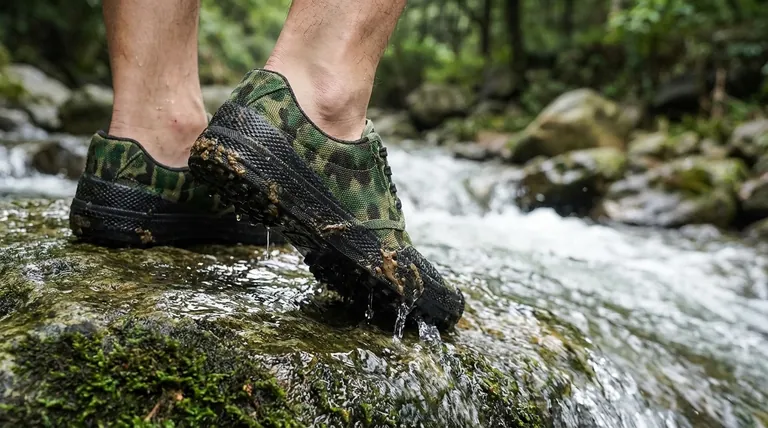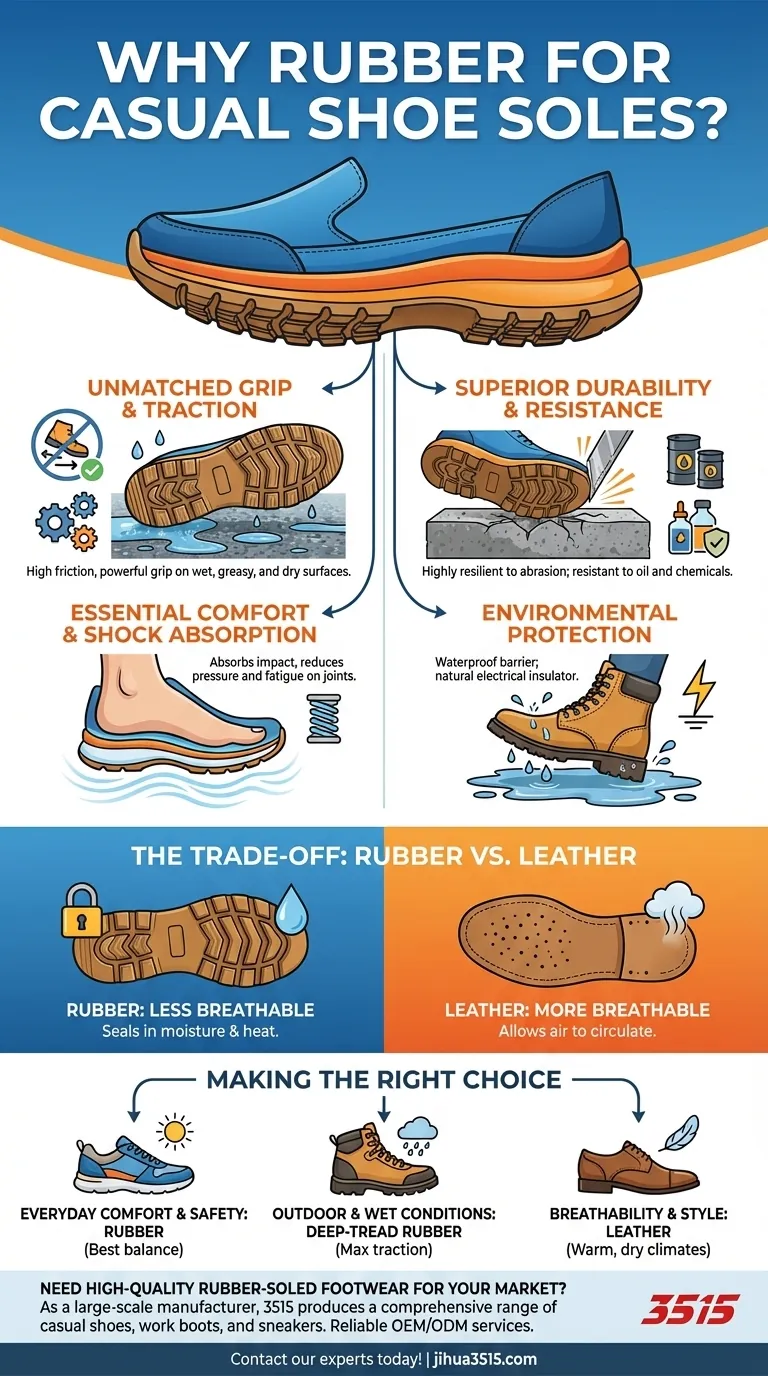At its core, rubber is the material of choice for casual shoe soles because of its exceptional combination of properties. It provides excellent grip for safety, high flexibility and shock absorption for comfort, and significant durability for a long lifespan on hard surfaces like concrete and asphalt.
The true value of rubber in footwear is not just its grip, but its remarkable versatility. Different rubber formulations can be engineered for specific goals—from casual comfort to industrial safety—though this performance often comes at the trade-off of reduced breathability compared to traditional materials like leather.

The Fundamental Properties of a Rubber Sole
To understand why rubber is so ubiquitous, we need to look at its core performance characteristics. These qualities work together to create a sole that is both protective and comfortable for daily wear.
Unmatched Grip and Traction
The most critical safety feature of any sole is its ability to prevent slips. Rubber has a naturally high coefficient of friction, which gives it a powerful grip on a wide variety of surfaces.
This is true for everyday terrains like pavement but also for more hazardous, slippery conditions like wet or even greasy floors. This property is the primary reason rubber is trusted for everything from sneakers to work boots.
Superior Durability and Resistance
Casual shoes are subjected to constant wear and abrasion. Rubber is highly resilient, resisting damage from being scraped against hard surfaces like concrete.
Furthermore, specific rubber compounds are engineered to be resistant to oil and various chemicals, making them an essential choice for demanding work environments where longevity and protection are paramount.
Essential Comfort and Shock Absorption
Every step you take sends an impact shock through your feet and up your legs. Rubber’s natural elasticity allows it to absorb a significant portion of this shock.
This quality reduces pressure and fatigue on your feet and joints, which is a key component of what makes a shoe feel comfortable throughout a long day of walking.
Environmental Protection
Beyond simple comfort, rubber soles act as a barrier. Its structure is naturally waterproof, completely blocking water from seeping into the shoe from below, which is ideal for wet or muddy conditions.
It is also a natural electrical insulator, providing a layer of safety in environments with potential electrical hazards.
Understanding the Trade-offs: Rubber vs. Leather
No material is perfect for every application. While rubber dominates casual and performance footwear, it's important to understand its limitations, especially when compared to traditional leather soles.
The Breathability Factor
The primary drawback of rubber is that it is not breathable. By sealing out water, it also seals in moisture and heat, which can lead to warmer, sweatier feet.
In contrast, leather is a porous material that allows air to circulate, making leather-soled shoes a more comfortable choice in hot, dry weather.
Weight and Flexibility
While rubber is flexible, certain high-durability or thick-treaded rubber soles can be heavier and feel stiffer than a comparable leather sole.
Dress shoes often use leather to maintain a lighter weight and a more refined, flexible feel that conforms to the foot over time.
Making the Right Choice for Your Goal
The ideal sole material depends entirely on the shoe's intended purpose. By understanding these key differences, you can select footwear that is perfectly aligned with your needs.
- If your primary focus is everyday comfort and all-weather safety: A standard rubber sole offers the best all-around balance of grip, shock absorption, and durability.
- If your primary focus is outdoor activities or wet conditions: Prioritize a shoe with a deep-treaded rubber sole for maximum traction and water resistance.
- If your primary focus is breathability and formal style: A traditional leather sole remains the superior choice, particularly in warm, dry climates.
Choosing the right footwear is about matching the material's properties to your environment and activity.
Summary Table:
| Property | Key Benefit for Casual Shoes |
|---|---|
| Grip & Traction | Prevents slips on wet, dry, and greasy surfaces for safety. |
| Durability & Resistance | Withstands abrasion from concrete and resists oils/chemicals. |
| Shock Absorption | Reduces impact on feet and joints for all-day comfort. |
| Environmental Protection | Waterproof barrier and natural electrical insulator. |
Need high-quality rubber-soled footwear for your market?
As a large-scale manufacturer, 3515 produces a comprehensive range of durable and comfortable casual shoes, work boots, and sneakers with advanced rubber soles. We provide reliable OEM/ODM services for distributors, brand owners, and bulk clients seeking footwear that combines safety, comfort, and long-lasting performance.
Contact our experts today to discuss your production needs and get a quote!
Visual Guide

Related Products
- Wholesale Durable Camouflage Canvas Shoes with High-Traction Cleated Rubber Sole
- Wholesale Comfortable Business Casual Shoes Custom Manufacturing
- Wholesale Breathable Training Shoes Custom Athletic Footwear Manufacturer
- Durable Canvas Work Shoes with Rubber Lug Sole | Wholesale Manufacturer
- Wholesale Breathable Athletic Sneakers - Custom Lightweight Cushioned Footwear Manufacturer
People Also Ask
- Which type of sole is better for premium sneakers and why? The Definitive Guide to Rubber Outsoles
- Why should we wear rubber soled shoes? Unlock Superior Safety and Durability
- What are the properties of canvas as a shoe material? A Guide to Lightweight Comfort & Style
- What are the benefits of using rubber soles on sneakers? Superior Grip, Durability & Comfort
- How have sneaker brands incorporated camouflage patterns? From Military to Streetwear Style



















